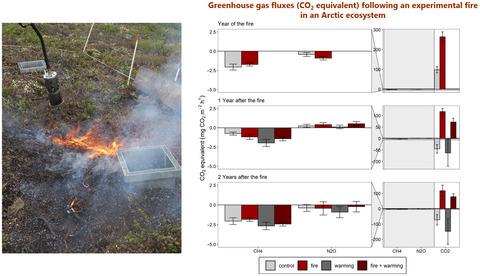当前位置:
X-MOL 学术
›
Glob. Change Biol.
›
论文详情
Our official English website, www.x-mol.net, welcomes your
feedback! (Note: you will need to create a separate account there.)
Effects of fire on CO2, CH4, and N2O exchange in a well-drained Arctic heath ecosystem
Global Change Biology ( IF 10.8 ) Pub Date : 2022-05-11 , DOI: 10.1111/gcb.16222 Lena Hermesdorf 1 , Bo Elberling 1 , Ludovica D'Imperio 1, 2 , Wenyi Xu 1 , Anders Lambaek 1 , Per L Ambus 1
Global Change Biology ( IF 10.8 ) Pub Date : 2022-05-11 , DOI: 10.1111/gcb.16222 Lena Hermesdorf 1 , Bo Elberling 1 , Ludovica D'Imperio 1, 2 , Wenyi Xu 1 , Anders Lambaek 1 , Per L Ambus 1
Affiliation

|
Wildfire frequency and expanse in the Arctic have increased in recent years and are projected to increase further with changes in climatic conditions due to warmer and drier summers. Yet, there is a lack of knowledge about the impacts such events may have on the net greenhouse gas (GHG) balances in Arctic ecosystems. We investigated in situ effects of an experimental fire in 2017 on carbon dioxide (CO2), methane (CH4), and nitrous oxide (N2O) surface fluxes in the most abundant tundra ecosystem in West Greenland in ambient and warmer conditions. Measurements from the growing seasons 2017 to 2019 showed that burnt areas became significant net CO2 sources for the entire study period, driven by increased ecosystem respiration (ER) immediately after the fire and decreased gross ecosystem production (GEP). Warming by open-top chambers significantly increased both ER and GEP in control, but not in burnt plots. In contrast to CO2, measurements suggest that the overall sink capacity of atmospheric CH4, as well as net N2O emissions, were not affected by fire in the short term, but only immediately after the fire. The minor effects on CH4 and N2O, which was surprising given the significantly higher nitrate availability observed in burnt plots. However, the minor effects are aligned with the lack of significant effects of fire on soil moisture and soil temperature. Net uptake and emissions of all three GHG from burnt soils were less temperature-sensitive than in the undisturbed control plots. Overall, this study highlights that wildfires in a typical tundra ecosystem in Greenland may not lead to markedly increased net GHG emissions other than CO2. Additional investigations are needed to assess the consequences of more severe fires.
中文翻译:

火灾对排水良好的北极荒地生态系统中 CO2、CH4 和 N2O 交换的影响
近年来,北极的野火频率和范围有所增加,预计随着夏季温暖和干燥导致气候条件的变化,野火的频率和范围将进一步增加。然而,对于此类事件可能对北极生态系统中的净温室气体 (GHG) 平衡产生的影响缺乏了解。我们调查了 2017 年实验火灾对环境和温暖条件下西格陵兰最丰富的苔原生态系统中二氧化碳 (CO 2 )、甲烷 (CH 4 ) 和一氧化二氮 (N 2 O) 表面通量的原位影响。2017 年至 2019 年生长季节的测量结果表明,烧毁区域成为重要的净 CO 2整个研究期间的资源,由火灾后立即增加的生态系统呼吸 (ER) 和减少的生态系统总产量 (GEP) 驱动。开顶室的升温显着增加了对照中的 ER 和 GEP,但在烧毁的地块中没有。与 CO 2相比,测量结果表明大气 CH 4的总汇容量以及净 N 2 O 排放量在短期内不受火灾影响,而仅在火灾发生后立即受到影响。对 CH 4和 N 2的轻微影响O,这是令人惊讶的,因为在烧毁的地块中观察到的硝酸盐可用性显着更高。然而,较小的影响与火灾对土壤水分和土壤温度缺乏显着影响相一致。燃烧土壤中所有三种温室气体的净吸收和排放对温度的敏感性低于未受干扰的对照地块。总体而言,本研究强调格陵兰典型苔原生态系统中的野火可能不会导致除 CO 2之外的温室气体净排放量显着增加。需要进一步调查以评估更严重火灾的后果。
更新日期:2022-05-11
中文翻译:

火灾对排水良好的北极荒地生态系统中 CO2、CH4 和 N2O 交换的影响
近年来,北极的野火频率和范围有所增加,预计随着夏季温暖和干燥导致气候条件的变化,野火的频率和范围将进一步增加。然而,对于此类事件可能对北极生态系统中的净温室气体 (GHG) 平衡产生的影响缺乏了解。我们调查了 2017 年实验火灾对环境和温暖条件下西格陵兰最丰富的苔原生态系统中二氧化碳 (CO 2 )、甲烷 (CH 4 ) 和一氧化二氮 (N 2 O) 表面通量的原位影响。2017 年至 2019 年生长季节的测量结果表明,烧毁区域成为重要的净 CO 2整个研究期间的资源,由火灾后立即增加的生态系统呼吸 (ER) 和减少的生态系统总产量 (GEP) 驱动。开顶室的升温显着增加了对照中的 ER 和 GEP,但在烧毁的地块中没有。与 CO 2相比,测量结果表明大气 CH 4的总汇容量以及净 N 2 O 排放量在短期内不受火灾影响,而仅在火灾发生后立即受到影响。对 CH 4和 N 2的轻微影响O,这是令人惊讶的,因为在烧毁的地块中观察到的硝酸盐可用性显着更高。然而,较小的影响与火灾对土壤水分和土壤温度缺乏显着影响相一致。燃烧土壤中所有三种温室气体的净吸收和排放对温度的敏感性低于未受干扰的对照地块。总体而言,本研究强调格陵兰典型苔原生态系统中的野火可能不会导致除 CO 2之外的温室气体净排放量显着增加。需要进一步调查以评估更严重火灾的后果。

































 京公网安备 11010802027423号
京公网安备 11010802027423号